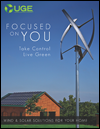Absolute Humidity: A type of humidity that considers the mass of water vapor present per unit volume of space. Also considered as the density of the water vapor. It is usually expressed in grams per cubic meter.
AC: Alternating current, where the electrical current switches directions a fixed number of times per second (such as 60 times per second or 60 Hz)
Air Density: density of air in terms of mass of air per unit volume. Air density directly affects amount of power that is transferred to a wind turbine. Heavier air produces more energy from turbines and vice versa.
Anemometer: A device to measure wind speed.
Annual Energy Output: The total energy produced by a wind turbine over the course of a year.
Armature: The generator component that contains the armature wires and is the source of the electrical current.
Armature Tube: The generator component that supports the armature and secures the top bearing to the base pole
Average Wind Speed: The mean wind speed over a specified period of time.
Beaufort Scale: An empirical measure for describing wind speed based mainly on observed sea conditions. Its full name is the Beaufort wind force scale.
Betz Coefficient--59.3 percent: This is the theoretical maximum efficiency at which a wind generator can operate.
Braking System: A device to slow a wind turbine's shaft speed down to safe levels electrically or mechanically.
Cut-In Wind Speed: The lowest wind speed at which the turbine starts to produce power.
Darrieus: A Vertical Axis Wind Turbine design from the 1920s and 1930s by F.M. Darrieus, a French wind turbine designer.
Decibel: A unit used to express relative difference in power or intensity, usually between two acoustic or electric signals, equal to ten times the common logarithm of the ratio of the two levels.
Drag: In a wind generator, the force exerted on an object by moving air. Also refers to a type of wind generator or anemometer design that uses cups instead of a blades with airfoils.
Efficiency: The ratio of energy output to energy input in a device.
Electric Grid: A system of transmission and distribution lines connecting synchronized power providers and consumers. Interconnects and facilitates the distribution of electricity to consumers.
Foundation Template: A steel template that positions the foundation rods when pouring the foundation concrete.
Generator: The Windspire component that converts rotational torque to electricity and protects the grid-tie inverter.
Gin Pole: A required lever support tool for raising or lowering the Windspire.
Grid: The utility distribution system. The network that connects electricity generators to electricity users.
Ground Wire: Wire supplied with the foundation kit that attaches to the lower hinge plate.
Horizontal Axis Wind Turbine (HAWT): A wind turbine design, in which the shaft is parallel to the ground, and the blades are perpendicular to the ground.
Inverter: A device that converts direct current (DC) to alternating current (AC).
Kilowatt: 1,000 watts, an instantaneous measure of energy.
Kilowatt Hour: Standard unit of electricity or consumption equal to 1000 watts over one hour. When you use 1000 watts for 1 hour, that's a kilowatt-hour.
Lift: The force exerted by moving air on asymmetrically-shaped wind generator blades at right angles to the direction of relative movement. Ideally, wind generator blades should produce high Lift and low Drag.
Power Curve: A graph that shows the power output of a wind turbine generator relative to different wind.
Power Output: The amount of power produced by a wind turbine at a given speed.
Rated Power: Power output at a specified wind speed.
Rated Wind Speed: The specified wind speed at which a wind turbine's rated power is achieved.
Rayleigh Wind Speed Distribution: A statistical curve whose shape approximates the actual shape of a wind speed distribution curve. It is used as a standardized distribution curve to estimate the energy production performance of a wind turbine.
Rotor: The assembly that encompasses all airfoils and rotor rings.
Rotor Rings: Aircraft-grade aluminum rings that attach to the top and bottom of the rotor for safety.
Rotor Speed: The revolutions per minute of the wind turbine rotor.
Savonius: A vertical-axis wind turbine design by S.J. Savonius of Finland from the 1920s and 30s. Shaped like a barrel split from end to end and offset along the cut. They are drag machines, and thus give very low rpm but lots of torque.
Swept Area: The power output of a wind turbine is directly related to the swept area of its blades. This is calculated in a VAWT by h x w.
Tip Speed Ratio: The speed at the tip of the rotor blade as it moves through the air divided by the wind velocity. This is typically a design requirement for the turbine.
Turbulence: Irregular changes in wind speed and direction in the horizontal and vertical planes.
Vertical Axis Wind Turbine (VAWT): A wind generator design where the rotating shaft is perpendicular to the ground, and the cups or blades rotate parallel to the ground.
Watt: One Joule of electrical energy per second.
Wind Direction: Winds are described by the direction in which they come from.
Wind Turbine: A machine that captures the force of the wind to produce electricity.
Windmill: A device that uses wind power to mill grain into flour.
If you cannot find the definition you are looking for, please contact us.


